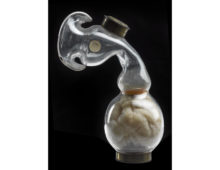Tagged with Children
Resource : The Rajah Quilt
Transportation was an extremely harsh punishment of the 1700s and 1800s, second only to execution. Between 1787 and 1852 as many as 25,000 women were transported from Britain to Australia to work in penal colonies, for crimes as varied as petty theft and poaching, to murder. Their sentences were often miscarriages of justice. Many didn’t survive the long journey. Most of them never returned. This remarkable quilt was made by women transported to Tasmania in 1841.
Resource : The factory child’s trouble – sampler
This is a sampler that records the sufferings of a child, working in one of the many textile mills in Salford (Greater Manchester). It was sewn by Elizabeth Hodgates who was 12 years old in 1833 and reminds us of the terrible working conditions for children, women and men during the industrial revolution.
Resource : Tokens given by mothers to their children on leaving them at the Foundling Hospital
This is a selection of tokens from mothers who, unable to keep their babies, left them at the Foundling Hospital in London. They highlight the plight of single mothers and destitute families unable to care for their children and are a poignant reminder of the growing poverty crisis as cities became more heavily industrialised and workers more mobile during the Age of Revolution. Many babies were left anonymously by their mothers, along with a token to identify them, in the hope that they might be reunited in the future.
Resource : Portrait of Elizabeth Fry
Elizabeth Gurney Fry (1780 – 1845) was a social reformer, best remembered for her work improving conditions for people in prison. She was the first female prison reformer in Europe, and probably the best known of her time. She became known as ‘the angel of the prisons.’
Resource : View of New Lanark by John Winning
Throughout the 1800s Britain became a busy industrial nation. People migrated in increasing numbers from the countryside to towns and cities to work in new factories and mills. Working conditions were poor and dangerous, injuries from machinery were common and workers – including children as young as six – worked long hours. Overcrowding, limited diets and polluted water led to widespread disease and early death. New Lanark, a village on the River Clyde near Glasgow, was a revolutionary industrial and housing complex, combining a cotton mill with purpose-built housing, education and social care for its workers and their families. The ideas put into practice here marked the beginning of cooperative socialism.
Resource : The life and adventures of Michael Armstrong, the factory boy by Frances Trollope
This illustrated novel by Frances Trollope (1779-1863) was published in monthly parts in 1840, costing one shilling apiece. It tells a fictional story of Michael Armstrong, based on the real-life hardships, exploitation and suffering of children in the workplaces of the Industrial Revolution. It was the first novel about industrial life in Britain and made an important contribution to the campaign to reform conditions for workers – especially children.


